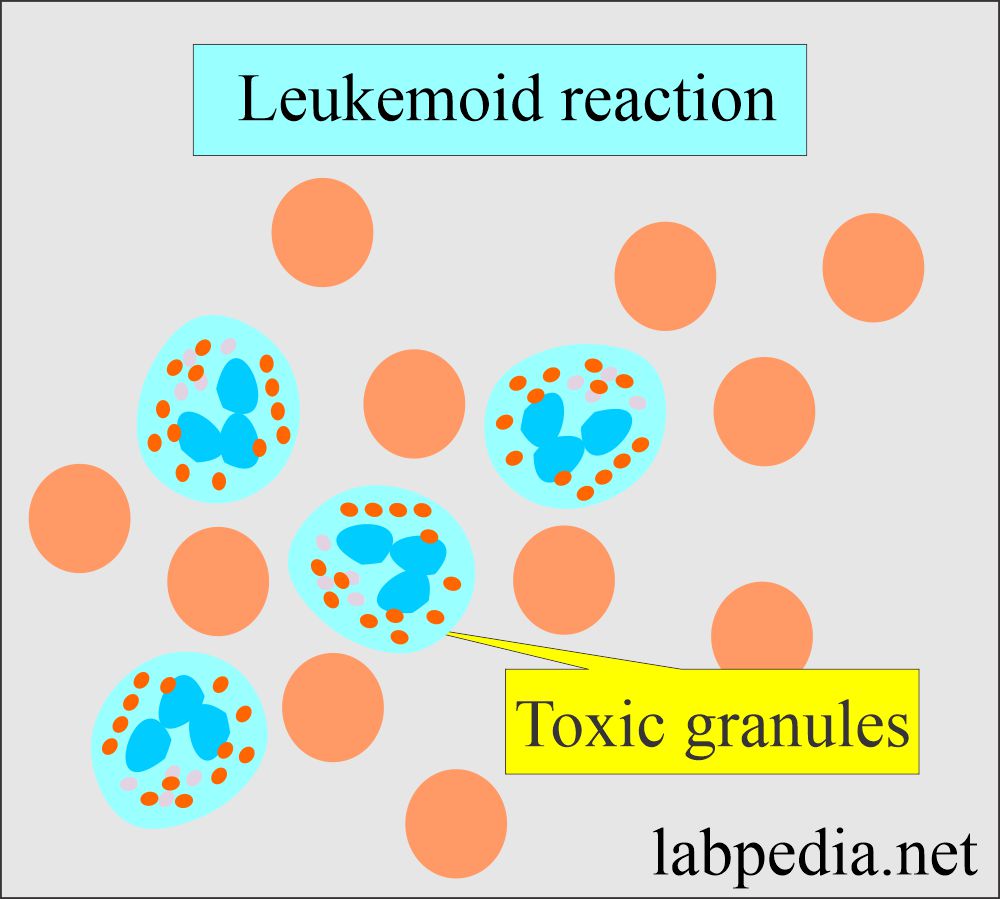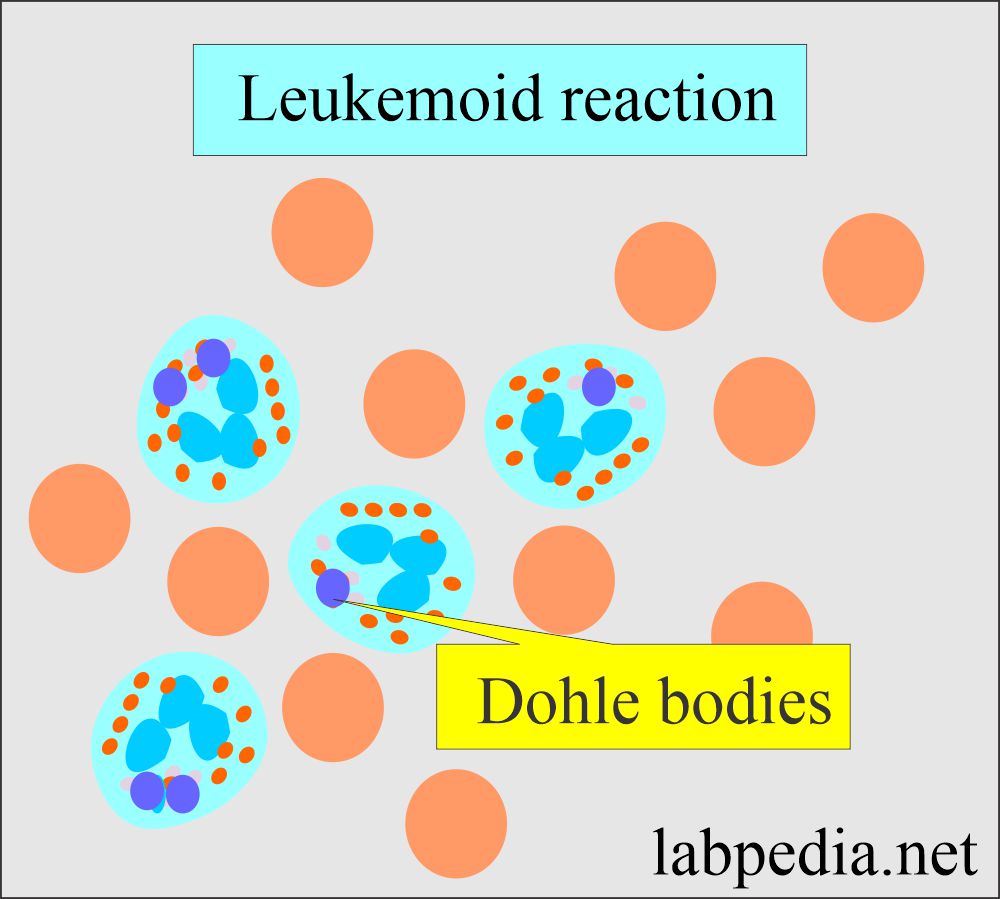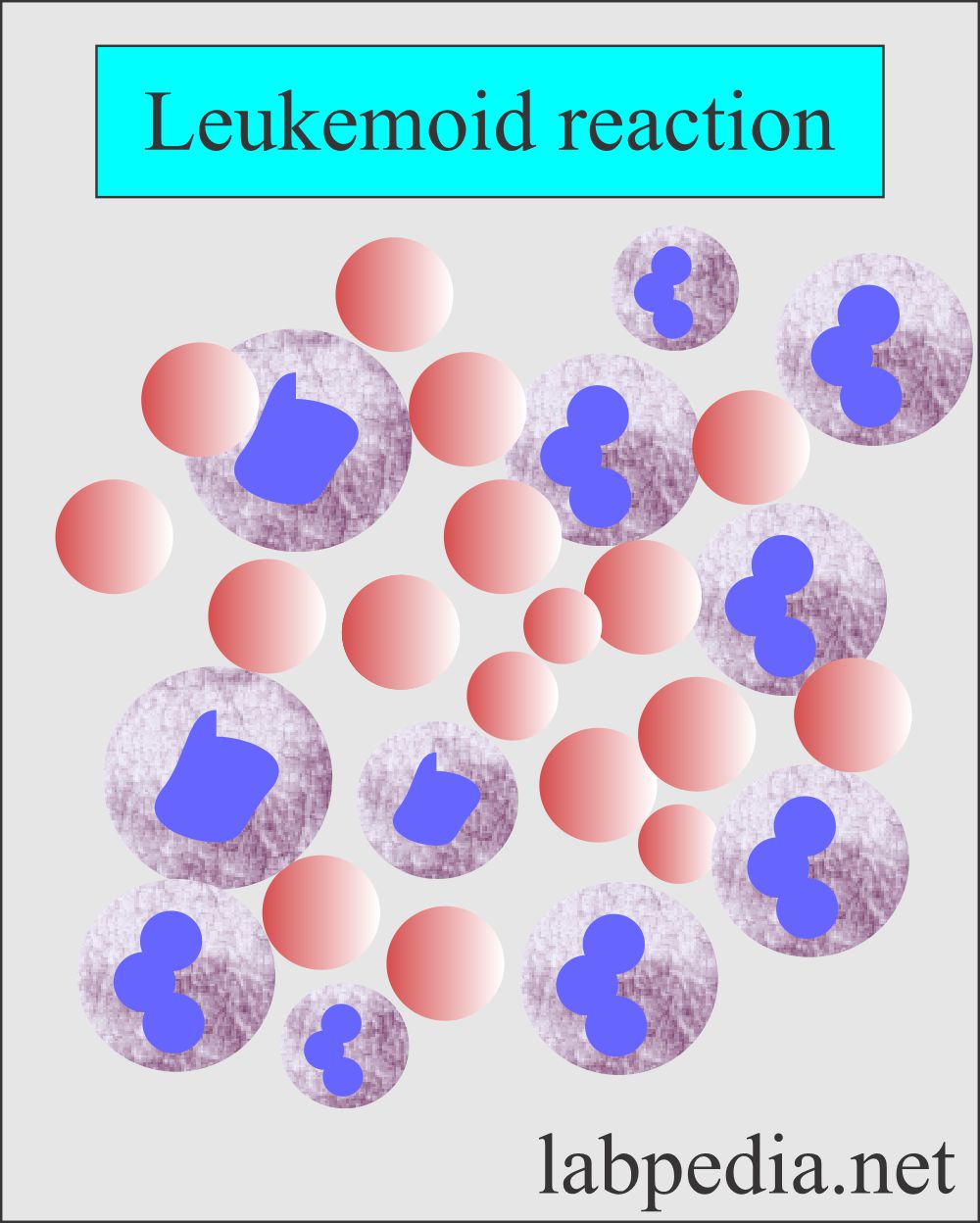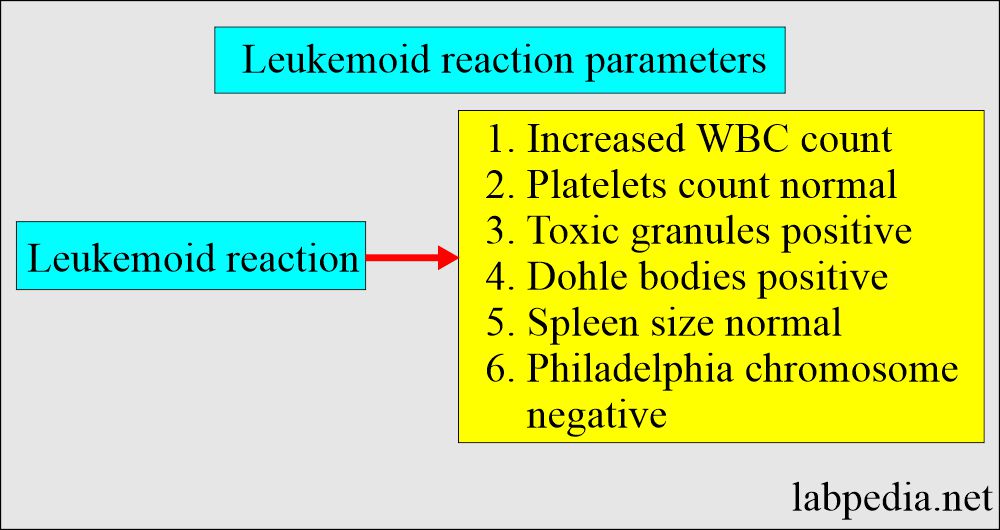Leukemoid Reaction and Diagnosis (D/D from Chronic Myelocytic leukemia)
Leukemoid Reaction
What sample is needed to diagnose leukemoid reaction?
- Blood in EDTA is needed, along with a fresh blood smear.
How will you define Leukemoid Reaction?
- Suppose there is a persistent increase in neutrophils, reactive and excessive leucocytosis with a count of 30,000 to 50,000/µL, with immature and mature white cells in the peripheral blood smear. In that case, it is called a Leukemoid reaction. Sometimes, lymphocytic reactions may be seen.
- This is not a primary marrow disorder, and this is due to secondary infections.
- The count varies from 50,000 to 100,000/cmm. With the presence of immature cells.
- Blast cells in the peripheral blood smears are not seen, which helps differentiate from leukemia.
- Extremely elevated counts >100,000/cmm are more suggestive of the myeloproliferative process, with some exceptions.
What are the types of leukemoid reactions?
- Neutrophilic reaction.
- Lymphocytic reaction.
- Monocytic reaction.
What is the significance of a leukemoid reaction?
- This term is used to differentiate between leucocytosis and leukemia.
- In leukocytosis or neutrophilia, the count increases from 10,000 to 25,000 / µL (microliter).
What is the pathogenesis of leukemoid reaction?
- Leucocytosis results from releasing the cells from the bone marrow under the influence of IL-1 and TNF.
- There is a shift to the left of the neutrophils.
- Prolonged infection induces in the bone marrow the proliferation of the precursor cells, and cytokines like IL-1 and TNF also produce that.
- Bacterial infections induce a selective increase in neutrophils, while parasitic infestation induces eosinophilia.
- Mumps, Rubella, and some viruses lead to a selective increase in the lymphocytes and cause lymphocytosis.
How will you differentiate Leukemia from a Leukemoid reaction?
- In the leukemoid reaction, the neutrophils are mature and not clonally derived.
- There is a persistent increase in TLC above 50,000/cmm and no evidence of leukemia.
- Blood count comes to normal after treating the cause.
- Increased blast cells are not seen in the leukemoid reaction.
- A count above 100,000 /µL suggests a myeloproliferative disorder with few exceptions.
- Granulocytes show toxic granulations and Dohle bodies.
- NAP score is high, which is low in leukemia.
- The leukemoid reaction shows:
- Toxic granulations.
-
- Toxic vacuolization.
- Presence of Dohle bodies. These are light blue to grey, oval, and basophilic inclusions in the neutrophils. Usually seen in the peripheral area of the cytoplasm of neutrophils. These consist of ribosomes and endoplasmic reticulum.
What is the Differential diagnosis of leukemoid reaction?
- Chronic myeloid leukemia.
What are the causes of the leukemoid reaction (Neutrophil type)?
- A severe infection:
- Septicemia.
- Clostridium.
- Tuberculosis.
- Pertussis.
- Infectious mononucleosis.
- Endocarditis.
- Pneumonia.
- Tuberculosis.
- Toxic conditions:
- Eclampsia.
- Burns.
- Mercury poisoning.
- Parasitic infestation:
- Larval migration leads to eosinophilia.
- Leukemoid lymphocytosis:
- It is seen in Tuberculosis, Whooping cough, and infectious mononucleosis.
- Malignancy:
- Carcinoma of the colon.
- Embryonal carcinoma of kidneys.
- Miscellaneous causes:
- Severe hemorrhage.
- Acute hemolysis.
- Diabetic ketoacidosis.
- Ischemic colitis.
- Hepatic necrosis.
- Drugs:
- Like Sulfa, Dapsone, Glucocorticoids, and the G-CSF factor.
When will you see a Lymphocytic leukemoid reaction?
- Infections:
- Infectious mononucleosis.
- Pertussis.
- Varicella.
- Tuberculosis.
- Malignancies:
- Carcinoma of the stomach.
- Carcinoma of the breast.
- Others like Dermatitis herpetiformis.
When will you see a Monocytic leukemoid reaction?
- It is seen in tuberculosis.
What are the causes of leukemoid reactions?
| Causes of leukemoid reaction | Myelocytic type | Lymphocytic type | Monocytic type |
|
|
|
|
|
|
||
|
|
|
|
|
|
|
|
|
Myeloproliferative disorders | Myeloproliferative disorders |
What are the differentiating points between Leukemoid reaction and chronic myelocytic leukemia?
| Clinical parameters | Leukemoid reaction | Chronic myeloid leukemia |
| What is the basis | Physiological process | Pathological process |
| WBC count | usually <50,000/cmm ( rarely > 60 x 109/L) | usually >50,000/cmm (50 to 500 x 109/L) |
| Basophils | absent | usually increased count |
| platelets | normal | Increased |
| Eosinophil | normal | Increased |
| Hemoglobin | usually normal | usually low |
| Band form | These are prominent | all stages (myelocytes) |
| Toxic granules and Dohle bodies | These are present | toxic granules ± to 0 |
| Spleen | usually not present | usually enlarged |
| Philadelphia chromosome | absent | present in 90% of the cases |
| Leucocytes Alk. phosphatase (LAP) score | normal or increased > 100 | < 10 (Decreased) |
| History | short | long |
| After the treatment | Count becomes normal | This may still be raised |
Questions and answers:
Question 1: What is the difference between leukemoid reaction and leukemia.
Question 2: What are the types of leukemoid reaction.





I agree with you